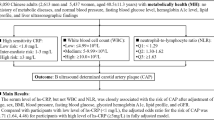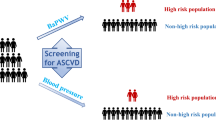Abstract
Intima-media thickness (IMT), plaque score (PS), and brachial-ankle pulse wave velocity (baPWV) are noninvasive parameters used for the evaluation of atherosclerosis. There have been no reports investigating the associations between IMT, PS, or baPWV and known risk factors for atherosclerosis in the same participants. This study aimed to compare the contributing risk factors among IMT, PS, and baPWV. We enrolled 3128 male participants who underwent health checkups. Carotid ultrasonography was used to measure IMT and PS, and baPWV was measured using an automatic device. We analyzed the association between these parameters and risk factors for atherosclerosis including obesity, smoking, alcohol, high blood pressure (BP), impaired fasting glucose (IFG), dyslipidemia (DL), and high-sensitivity C-reactive protein (hs-CRP). Multivariate logistic regression analysis revealed high IMT (>0.9 mm) to be independently associated with high BP. The presence of atherosclerosis (PS ≥ 1.1 mm) was independently associated with high BP, IFG, and DL. In addition, advanced atherosclerosis (PS ≥ 5.1 mm) showed a significant association with high BP, IFG, DL, log hs-CRP, and smoking. High baPWV (≥1600 cm/s) was significantly correlated with high BP, IFG, and log hs-CRP. IMT, PS, and baPWV were all associated with different risk factors among male Japanese participants. Only high BP was a common risk factor for all three parameters. Furthermore, hs-CRP was associated with advanced atherosclerosis but not with the presence of atherosclerosis.
This is a preview of subscription content, access via your institution
Access options
Subscribe to this journal
Receive 12 print issues and online access
$259.00 per year
only $21.58 per issue
Buy this article
- Purchase on Springer Link
- Instant access to full article PDF
Prices may be subject to local taxes which are calculated during checkout

Similar content being viewed by others
References
Hollander M, Hak AE, Koudstaal PJ, Bots ML, Grobbee DE, Hofman A, et al. Comparison between measures of atherosclerosis and risk of stroke: the Rotterdam Study. Stroke. 2003;10:2367–72. https://doi.org/10.1161/01.STR.0000091393.32060.0E.
Geisel MH, Bauer M, Hennig F, Hoffmann B, Lehmann N, Möhlenkamp S, et al. Comparison of coronary artery calcification, carotid intima-media thickness and ankle-brachial index for predicting 10-year incident cardiovascular events in the general population. Eur Heart J. 2017;38:1815–22. https://doi.org/10.1093/eurheartj/ehx120.
Hansson GK. Inflammation, atherosclerosis, and coronary artery disease. N Engl J Med. 2005;352:1685–95. https://doi.org/10.1056/nejmra043430.
Kawada T, Andou T, Fukumitsu M. Metabolic syndrome showed significant relationship with carotid atherosclerosis. Heart Vessels. 2016;31:664–70. https://doi.org/10.1007/s00380-015-0668-y.
Kawai T, Ohishi M, Yakeya Y, Ohnishi M, Ito N, Oguro R, et al. Carotid plaque score and intima media thickness as predictors of stroke and mortality in hypertensive patients. Hypertens Res. 2013;36:902–9.
Chan SY, Mancini GB, Kuramoto L, Schulzer M, Frohlich J, Ignaszewski A. The prognostic importance of endothelial dysfunction and carotid atheroma burden in patients with coronary artery disease. J Am Coll Cardiol. 2003;42:1037–43. https://doi.org/10.1016/s0735-1097(03)00927-6.
Jonsen SH, Mathiesen EB, Joakimsen O, Stensland E, Wilsgaard T, Løchen ML, et al. Carotid atherosclerosis is a stronger predictor of myocardial infarction in women than in men a 6-year follow-up study of 6226 persons: the Tromsø study. Stroke. 2007;38:2873–80. https://doi.org/10.1116/strokeaha.107.487264.
Ohkuma T, Ninomiya T, Tomiyama H, Kario K, Hoshide S, Kita Y, et al. Brachial-ankle pulse wave velocity and the risk prediction of cardiovascular disease: an individual participant data meta-analysis. Hypertension. 2017;69:1045–52. https://doi.org/10.1161/HYPERTENSIONAHA.117.09097.
Nagasawa SY, Ohkubo T, Masaki K, Barinas-Mitchell E, Miura K, Seto T, et al. Associations between inflammatory markers and subclinical atherosclerosis in middle-aged White, Japanese-American and Japanese men: the ERA-JUMP study. J Atheroscler Thromb. 2015;22:590–8. https://doi.org/10.5551/jat.23580.
Ridker PM. Clinical application of C-reactive protein for cardiovascular disease detection and prevention. Circulation. 2003;107:363–9. https://doi.org/10.1161/01.cir.0000053730.47739.3c.
Tomiyama H, Shiina K, Vlachopoulos C, Iwasaki Y, Matsumoto C, Kimura K, et al. Involvement of arterial stiffness and inflammation in hyperuricemia-related development of hypertension. Hypertension 2018;72:739–45. https://doi.org/10.1161/hypertensionaha.11811390.
Rizzo M, Corrado E, Coppola G, Muratori I, Novo S. Prediction of cerebrovascular and cardiovascular events in patients with subclinical carotid atherosclerosis: the role of C-reactive protein. J Investig Med. 2008;56:32–40. https://doi.org/10.2310/jim.0b013e31816204ab.
Pleskovič A, Letonja MŠ, Vujkovac AC, Nikolajević Starčević J, Gazdikova K, Caprnda M. et al. C-reactive protein as a marker of progression of carotid atherosclerosis in subjects with type 2 diabetes mellitus. Vasa. 2017;46:187–92. https://doi.org/10.1024/0301-1526/a000614.
Kawai T, Ohishi M, Onishi M, Ito N, Takeya Y, Maekawa Y, et al. Cut-off value of brachial-ankle pulse wave velocity to predict cardiovascular disease in hypertensive patients: a cohort study. J Atheroscler Thromb. 2013;20:391–400. https://doi.org/10.5551/jat.15040.
Sillesen H, Sartori S, Sandholt B, Baber U, Mehran R, Fuster V. Carotid plaque thickness and carotid plaque burden predict future cardiovascular events in asymptomatic adult Americans. Eur Heart J Cardiovasc Imaging. 2018;19:1042–50. https://doi.org/10.1093/ehjci/jex239.
Bauer M, Delaney JA, Möhlenkamp S, Jöckel KH, Kronmal RA, Lehmann N, et al. Comparison of factors associated with carotid intima-media thickness in the Multi-ethnic Study of Atherosclerosis (MESA) and the Heinz Nixdorf Recall Study (HNR). J Am Soc Echocardiogr. 2013;26:667–73. https://doi.org/10.1016/j.echo.2013.03.011.
Caughey MC, Qiao Y, Windham BG, Gottesman RF, Mosley TH, Wasserman BA. Carotid intima-media thickness and silent brain infarctions in a biracial cohort: the atherosclerosis risk in communities (ARIC) Study. Am J Hypertens. 2018;31:869–75. https://doi.org/10.1093/ajh/hpy022.
Bonafini S, Giontella A, Tagetti A, Montagnana M, Benati M, Danese E, et al. Markers of subclinical vascular damages associate with indices of adiposity and blood pressure in obese children. Hypertens Res. 2019;42:400–10. https://doi.org/10.1038/s41440-018-0173-7.
Mackey RH, Sutton-Tyrrell K, Vaitkevicius PV, Sakkinen PA, Lyles MF, Spurgeon HA, et al. Correlates of aortic stiffness in elderly individuals: a subgroup of the Cardiovascular Health Study. Am J Hypertens. 2002;15:16–23. https://doi.org/10.1016/s0895-7061(01)02228-2.
Lane-Cordova AD, Kalil GZ, Wagner CJ, Sindler AL, Fiedorowicz JG, Ajibewa T, et al. Hemoglobin A1c and C-reactive protein are independently associated with blunted nocturnal blood pressure dipping in obesity-related prediabete. Hypertens Res. 2018;41:33–8. https://doi.org/10.1038/hr.2017.82.
Meyer ML, Tanaka H, Palta P, Cheng S, Gouskova N, Aguilar D, et al. Correlates of segmental pulse wave velocity in older adults: the atherosclerosis risk in communities (ARIC) study. Am J Hypertens. 2016;29:114–22. https://doi.org/10.1093/ajh/hpv079.
Wasserman BA, Sharrett AR, Lai S, Gomes AS, Cushman M, Folsom AR, et al. Risk factor associations with the presence of a lipid core in carotid plaque of asymptomatic individuals using high-resolution MRI: the multi-ethnic study of atherosclerosis (MESA). Stroke. 2008;39:329–35. https://doi.org/10.1161/STROKEAHA.107.498634.
Motobe K, Tomiyama H, Koji Y, Yambe M, Gulinisa Z, Arai T, et al. Cut-off value of the ankle-brachial pressure index at which the accuracy of brachial-ankle pulse wave velocity measurement is diminished. Circ J. 2005;69:55–60. https://doi.org/10.1253/circj.69.55.
Teramoto T, Sasaki J, Ishibashi S, Birou S, Daida H, Dohi S, et al. Executive summary of the Japan Atherosclerosis Society (JAS) guidelines for the diagnosis and prevention of atherosclerotic cardiovascular diseases in Japan-2012 version. J Atheroscler Thromb. 2013;20:517–23. https://doi.org/10.5551/jat.15792.
Sakaguchi M, Kitagawa K, Nagai Y, Yamagami H, Kondo K, Matsushita K, et al. Equivalence of plaque score and intima-media thickness of carotid ultrasonography for predicting severe coronary artery lesion. Ultrasound Med Biol. 2003;29:367–71. https://doi.org/10.1016/s0301-5629(02)00743-3.
Naik V, Gamad RS, Bansod PP. Carotid artery segmentation in ultrasound images and measurement of intima-media thickness. BioMed Res Int. 2013;2013:801962. https://doi.org/10.1155/2013/801962.
Mancia G, Fagard R, Narkiewicz K, Redon J, Zanchetti A, Böhm M, et al. 2013 ESH/ESC guidelines for the management of arterial hypertension: the Task Force for the Management of Arterial Hypertension of the European Society of Hypertension (ESH) and of the European Society of Cardiology (ESC). Eur Heart J. 2013;34:2159–219. https://doi.org/10.1093/eurheartj/eht151.
Stein JH, Korcarz CE, Hurst RT, Lonn E, Kendall CB, Mohler ER, et al. Use of carotid ultrasound to identify subclinical vascular disease and evaluate cardiovascular disease risk: a consensus statement from the American Society of Echocardiography Carotid Intima-Media Thickness Task Force. Endorsed by the Society for Vascular Medicine. J Am Soc Echocard. 2008;21:93–111. https://doi.org/10.1016/j.echo.2008.01.002.
Takiuchi S, Kamide K, Miwa Y, Tomiyama M, Yoshii M, Matayoshi T, et al. Diagnostic value of carotid intima-media thickness and plaque score for predicting target organ damage in patients with essential hypertension. J Hum Hypertens. 2004;18:17–23. https://doi.org/10.1038/sj.jhh.1001628.
Yamashina A, Tomiyama H, Takeda K, Tsuda H, Arai T, Hirose K, et al. Validity, reproducibility, and clinical significance of noninvasive brachial-ankle pulse wave velocity measurement. Hypertens Res. 2002;25:359–64. https://doi.org/10.1291/hypres.25.359.
Munakata M. Brachial-ankle pulse wave velocity: background, method, and clinical evidence. Pulse. 2016;3:195–204. https://doi.org/10.1159/000443740.
Kubozono T, Miyata M, Kawasoe S, Ojima S, Yoshifuku S, Miyahara H, et al. High pulse wave velocity has a strong impact on early carotid atherosclerosis in a Japanese general male population. Circ J. 2017;81:310–5. https://doi.org/10.1253/circj.cj-16-0687.
Joo HJ, Cho SA, Cho JY, Lee S, Park JH, Hwang SH, et al. Brachial-ankle pulse wave velocity is associated with composite carotid and coronary atherosclerosis in a middle-aged asymptomatic population. J Atheroscler Thromb 2016;23:1033–46.
Ghiadoni L, Taddei S, Virdis A. Hypertension and endothelial dysfunction: therapeutic approach. Curr Vasc Pharm. 2012;10:42–60. https://doi.org/10.2174/157016112798829823.
Faeh D, William J, Yerly P, Paccaud F, Bovet P. Diabetes and pre-diabetes are associated with cardiovascular risk factors and carotid/femoral intima-media thickness independently of markers of insulin resistance and adiposity. Cardiovasc Diabetol. 2007;6:32. https://doi.org/10.1186/1475-2840-6-32.
Hanefeld M, Temelkova-Kurktschiev T, Schaper F, Henkel E, Siegert G, Koehler C. Impaired fasting glucose is not a risk factor for atherosclerosis. Diabet Med. 1999;16:212–8. https://doi.org/10.1046/j.1464-5491.1999.00072.x.
Kowall B, Ebert N, Then C, Thiery J, Koenig W, Meisinger C, et al. Associations between blood glucose and carotid intima-media thickness disappear after adjustment for shared risk factors: the KORA F4 study. PLoS One. 2012;7:e52590.
Libby P, Ridker PM, Hansson GK. Progress and challenges in translating the biology of atherosclerosis. Nature. 2011;473:317–25. https://doi.org/10.1038/nature10146.
Libby P, Ridker PM, Maseri A. Inflammation and atherosclerosis. Circulation. 2002;105:1135–43. https://doi.org/10.1161/hc0902.104353.
Kim M, Kim M, Yoo HJ, Lee SY, Lee SH, Lee JH. Age-specific determinants of pulse wave velocity among metabolic syndrome components, inflammatory markers, and oxidative stress. J Atheroscler Thromb. 2018;25:178–85. https://doi.org/10.5551/jat.39388.
Tomiyama H, Koji Y, Yambe M, Motobe K, Shiina K, Gulnisa Z, et al. Elevated C-reactive protein augments increased arterial stiffness in subjects with the metabolic syndrome. Hypertension. 2005;45:997–1003. https://doi.org/10.1161/01.hyp.0000165018.63523.8a.
Author information
Authors and Affiliations
Corresponding author
Ethics declarations
Conflict of interest
The authors declare that they have no conflict of interest.
Additional information
Publisher’s note Springer Nature remains neutral with regard to jurisdictional claims in published maps and institutional affiliations.
Rights and permissions
About this article
Cite this article
Ojima, S., Kubozono, T., Kawasoe, S. et al. Association of risk factors for atherosclerosis, including high-sensitivity C-reactive protein, with carotid intima-media thickness, plaque score, and pulse wave velocity in a male population. Hypertens Res 43, 422–430 (2020). https://doi.org/10.1038/s41440-019-0388-2
Received:
Revised:
Accepted:
Published:
Issue Date:
DOI: https://doi.org/10.1038/s41440-019-0388-2
Keywords
This article is cited by
-
Atherosclerosis and arteriosclerosis
Hypertension Research (2023)
-
Insufficient blood pressure control is independently associated with increased arterial stiffness
Hypertension Research (2022)
-
Comparison of the usefulness of the cardio-ankle vascular index and augmentation index as an index of arteriosclerosis in patients with essential hypertension
Hypertension Research (2022)
-
Associations between measurements of central blood pressure and target organ damage in high-risk patients
Clinical Hypertension (2021)
-
Anthropometric and metabolic pattern in obese Egyptian children: its association with C-reactive protein
Egyptian Pediatric Association Gazette (2020)



